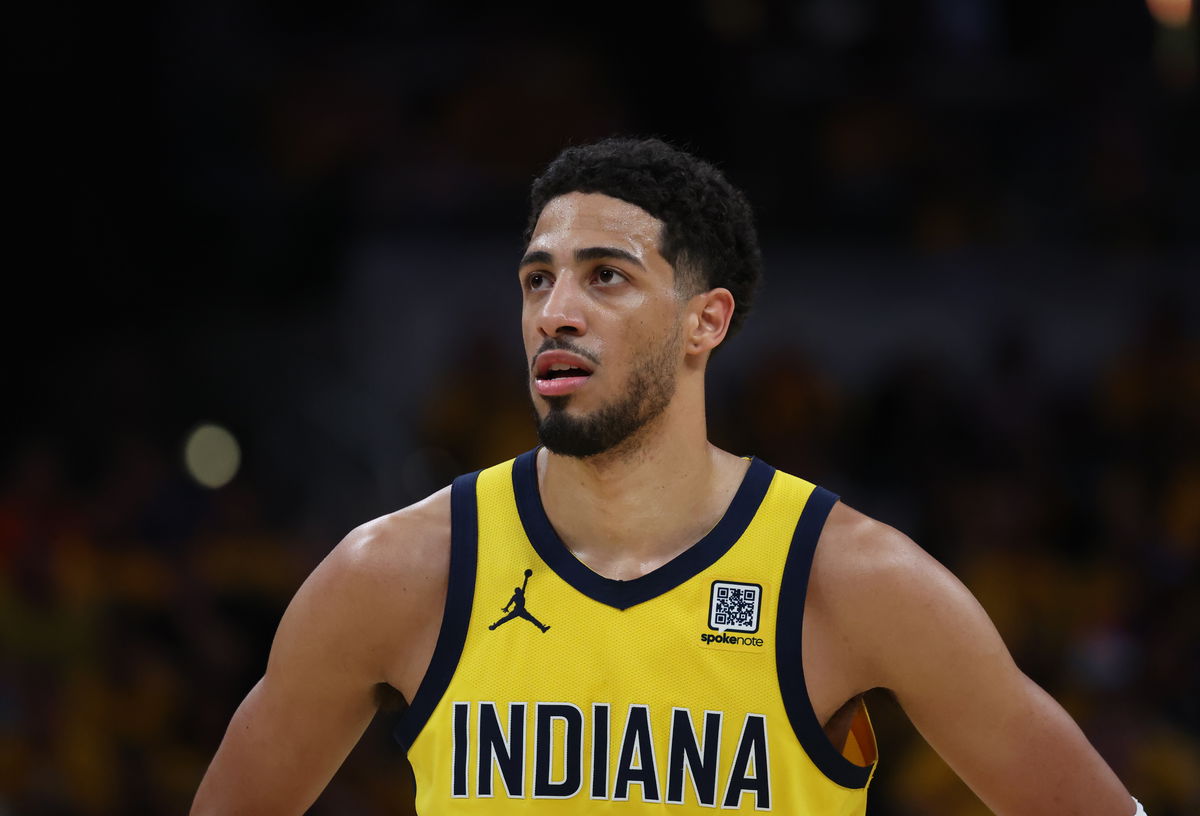
Imago
May 27, 2025; Indianapolis, Indiana, USA; Indiana Pacers guard Tyrese Haliburton (0) stands on court during the second quarter against the New York Knicks of game four of the eastern conference finals for the 2025 NBA Playoffs at Gainbridge Fieldhouse. Mandatory Credit: Trevor Ruszkowski-Imagn Images

Imago
May 27, 2025; Indianapolis, Indiana, USA; Indiana Pacers guard Tyrese Haliburton (0) stands on court during the second quarter against the New York Knicks of game four of the eastern conference finals for the 2025 NBA Playoffs at Gainbridge Fieldhouse. Mandatory Credit: Trevor Ruszkowski-Imagn Images
The arena went dead silent. One second, Tyrese Haliburton was drilling his third three-pointer in seven minutes, looking every bit like the superstar the Pacers needed to steal Game 7. Just when five minutes were left in the first quarter, Haliburton, who was already playing with a strained calf, attempted to dribble past Shai Gilgeous-Alexander, and the next moment he was on the floor. Unfortunately, Haliburton ended up injuring his right Achilles.
Watch What’s Trending Now!
The Pacers’ center, Myles Turner, who watched ‘The Haliban’ go down, was heartbroken in a mid-game interview. When talking to ESPN, Turner said, “It’s a heartbreak, man. It’s unfortunate.” Even Tyrese’s father, who first confirmed the Achilles’ injury, burst into tears. But what surprised everyone when 18,000 Thunder fans forgot they were supposed to be the villains.
ESPN’s cameras caught it all: the collective gasp, the hushed murmurs, Haliburton’s teammates’ stunned faces. Richard Jefferson’s call said what everyone was thinking: “The air was taken out of the entire building. The building went silent for the first time in all the games we’ve ever done here.”
ADVERTISEMENT
Then came the moment nobody expected. As trainers helped Haliburton limp off, Oklahoma City’s crowd—the same one that had been screaming on top of their lungs just minutes earlier—rose to its feet. Not just polite applause. A full, honest-to-God standing ovation. In a Game 7. Against their opponent’s best player. You don’t see that every day.
Tyrese’s biggest fan is heartbroken.
Hard to watch John Haliburton’s reaction. pic.twitter.com/KARRMIjWbs
— CycloneFanatic.com (@cyclonefanatic) June 23, 2025
Don’t get it twisted—the Thunder immediately went for the kill. Within minutes, they were on a 12-2 run, exploiting the gaping hole Haliburton left behind. The ovation didn’t change the scoreboard. But for one raw moment, basketball’s usual “us vs. them” script got flipped. The broadcast zoomed in on fans actually looking heartbroken, on Haliburton’s dad wiping his eyes in the stands.
ADVERTISEMENT
Here’s the brutal truth: Haliburton’s nine points in seven minutes might’ve been the start of something legendary. Instead, it’s now the NBA’s newest “what if.” But thanks to OKC‘s unexpected show of respect—and ESPN’s unflinching coverage—we’ll remember more than just the injury. We’ll remember the moment an entire arena remembered that there are things bigger than basketball.
ADVERTISEMENT
What Happened to Tyrese Haliburton Changed the Whole Game
Tyrese Haliburton’s dream NBA Finals run ended in agony. The Indiana Pacers’ star collapsed in pain after his right leg gave out on a routine drive in Game 7 against the Oklahoma City Thunder. It was one of the most excruciating sights. The arena fell silent—everyone knew this was more than just a cramp. Then came confirmation.
The moment it happened was as sudden as it was brutal. Haliburton had been playing through a strained right calf since Game 5, but medical experts now believe the initial injury may have already involved his Achilles. When he pushed off for a move in the first quarter, slow-motion replays showed the telltale a “pop” and a “ripple” up his calf—the unmistakable sign of a rupture. His father, John Haliburton, confirmed the worst live on ESPN: Tyrese’s Achilles indeed was involved in the injury.
Before the injury, Haliburton was on fire, hitting three three-pointers in just seven minutes. His early burst gave Pacers fans hope, but his sudden exit crushed it. The team, already fighting uphill against a tough Thunder squad, lost their floor general when they needed him most.
ADVERTISEMENT
Recovery won’t be quick. A torn Achilles usually takes 4-6 months just to heal, followed by months of grueling rehab. Players often struggle to regain their explosiveness, and the mental hurdle is just as tough. For Haliburton, a young superstar in his prime, this is a brutal setback.
The Pacers’ future now hangs in the balance. Can they bounce back without him next season? And will Haliburton return as the same electrifying playmaker? Only time will tell.
ADVERTISEMENT
ADVERTISEMENT
ADVERTISEMENT

